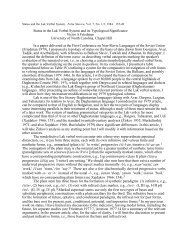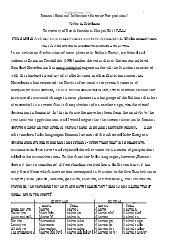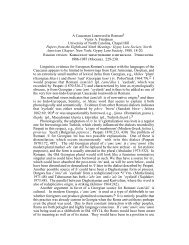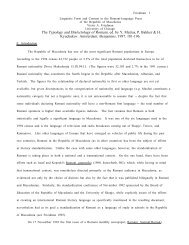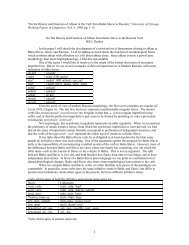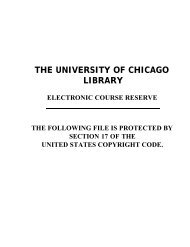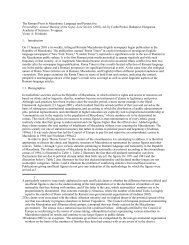Makedonia ve Civar Bölgelerde Balkan Türkçesi / Balkan Turkish in ...
Makedonia ve Civar Bölgelerde Balkan Türkçesi / Balkan Turkish in ...
Makedonia ve Civar Bölgelerde Balkan Türkçesi / Balkan Turkish in ...
You also want an ePaper? Increase the reach of your titles
YUMPU automatically turns print PDFs into web optimized ePapers that Google loves.
conditional for the <strong>in</strong>f<strong>in</strong>iti<strong>ve</strong>, by substitut<strong>in</strong>g lexical items or phrases for affixes of <strong>in</strong>terrogation<br />
and negativity, and by replac<strong>in</strong>g participial constructions with connectors plus f<strong>in</strong>ite <strong>ve</strong>rb forms.<br />
Matras (1990, 1996) analyzes the orig<strong>in</strong> and significance of the replacement of <strong>in</strong>f<strong>in</strong>itival<br />
clauses by subjuncti<strong>ve</strong> ones <strong>in</strong> Macedonian WRT, a phenomenon that is well attested <strong>in</strong> WRT <strong>in</strong><br />
general (Mollova 1968, Jasˇar-Nasteva 1970, Eckmann 1962, Kakuk 1960, 1972, Németh<br />
1965:97,109) as well as <strong>in</strong> East Rumelian <strong>Turkish</strong> and Gagauz (Mollova 1962, Guzev 1962,<br />
Mollov and Mollova 1966, Gajdarzˇi 1973, Pokrovskaja 1964:210, 1979). The use of the<br />
optati<strong>ve</strong>-subjuncti<strong>ve</strong> or 3 sg imperati<strong>ve</strong> to express <strong>in</strong>direct imperati<strong>ve</strong>s and clauses of goal also<br />
occurs <strong>in</strong> other Turkic languages and dialects (Kakuk 1960, Mollov and Mollova 1966), but the<br />
far greater frequency and wider range of such uses <strong>in</strong> <strong>Balkan</strong> <strong>Turkish</strong> <strong>in</strong>dicate the <strong>in</strong>fluence of<br />
non-<strong>Turkish</strong> <strong>Balkan</strong> languages. The expanded <strong>Turkish</strong> usage seems calqued from subord<strong>in</strong>ate<br />
clauses <strong>in</strong> Macedonian and Albanian us<strong>in</strong>g the particles da and të, respecti<strong>ve</strong>ly, which can<br />
function <strong>in</strong> subjuncti<strong>ve</strong>, optati<strong>ve</strong>, and conditional contexts <strong>in</strong> their respecti<strong>ve</strong> languages (see<br />
Friedman 1985). The follow<strong>in</strong>g examples with expressions of necessity are typical of WRT<br />
usage and are gi<strong>ve</strong>n with their Macedonian and Albanian equivalents:<br />
(2) Lâzım gideyim (Zekeriya 1978:.38) Treba da odam/Duhet të shkoj 'I ha<strong>ve</strong> to go'<br />
(3) O köylerde läzım büyük agitatsiya yapılsın (Jasˇar-Nasteva 1957:149) vo tie sela<br />
treba da se napravi golema agitatsija/në këta fshatra duhet të bëhet agjitacion i madh '<strong>in</strong><br />
those villages some major consciousness rais<strong>in</strong>g needs to be done'<br />
Examples (4)-(5) show the optati<strong>ve</strong>-subjuncti<strong>ve</strong> and (6) the conditional after various f<strong>in</strong>ite <strong>ve</strong>rbs<br />
that would take <strong>in</strong>f<strong>in</strong>itval clauses <strong>in</strong> Standard <strong>Turkish</strong> but da/të clauses <strong>in</strong> Macedonian and<br />
Albanian:<br />
(4) Çocok celdi ekmek alsın (Jusuf 1987:132) 'The child came to get bread'<br />
(5) Bas¸layacam çalıs¸am (Zekeriya 1976:.7) 'I'll beg<strong>in</strong> to work'<br />
(6) Bas¸ladi yalan söylesa (Kakuk 1972:246) 'he began to tell lies'<br />
Examples (7) and (8) represent calques on Slavic. In example (7) the <strong>Turkish</strong> <strong>in</strong>terrogati<strong>ve</strong>possibiliti<strong>ve</strong><br />
is replaced by the dialectal equivalent of Standard <strong>Turkish</strong> olur mu modeled on<br />
Slavic mozˇe li 'is it possible?', while <strong>in</strong> (8) the Macedonian negati<strong>ve</strong> future, which is formed by a<br />
negati<strong>ve</strong> existential plus a da-clause (subjuncti<strong>ve</strong>) has been calqued by an equivalent construction<br />
<strong>in</strong> WRT:<br />
(7) Olor mi sizde celam (Yusuf 1977:67)=Size gelebilir miyiz/Mozˇe li kaj vas da<br />
dojdeme 'Can we come to your place'<br />
(8) Yoktur bizimle geles<strong>in</strong> (Zekeriya 1976:.10)=Bizimle gelmiyeceks<strong>in</strong>/Nema so nas da<br />
odisˇ 'You won't come [with us]<br />
The calqu<strong>in</strong>g and borrow<strong>in</strong>g of various conjunctions <strong>in</strong> WRT results <strong>in</strong> the reduction or<br />
elim<strong>in</strong>ation of participial constructions. Syntactic calqu<strong>in</strong>g of relativiz<strong>in</strong>g and coord<strong>in</strong>at<strong>in</strong>g<br />
conjunctions is also discussed <strong>in</strong> Matras (1996; see also Johanson 1975). Of particular <strong>in</strong>terest is<br />
the use of ne 'what' as a relativizer modeled on Macedonian sˇto as illustrated <strong>in</strong> examples (9)-<br />
(10):<br />
(9) çocoklar yemis¸lar pogaçay em oumay ne cetırdım. (Jusuf 1987:108). 'The children<br />
ha<strong>ve</strong> eaten the round loaf and apple that I brought.'<br />
(10) Cetır o çitabi ne <strong>ve</strong>rdım sana (Sana <strong>ve</strong>rdig˘im kitabı getir) (Yusuf 1977:65) 'Br<strong>in</strong>g that<br />
book which I ga<strong>ve</strong> you<br />
The use of ne zaman 'when?' as a calque on Macedonian koga Albanian kur 'when' as a relativizer<br />
as well as an <strong>in</strong>terrogati<strong>ve</strong> also ser<strong>ve</strong>s to elim<strong>in</strong>ate participial constructions (Kakuk 1972, Németh<br />
1965:110, Mollov and Mollova 1966),<br />
6



